I recently taught a workshop at a writer’s conference on Regency Ladies Fashions. One attendee asked what ladies wore underneath their skirts. You should have heard the gasps when I told her, “Nothing.” So, this seems to be a good time to repost about the somewhat controversial topic.
Historians, researchers, and authors agree that ladies wore a shift, or chemise, over which they laced up stays (a type of Regency corset but more comfortable), and then a petticoat, which was basically a long slip or jumper. We also know they wore stockings that tied or buckled.
Our modern-day sensibilities insist that the ladies who lived during the time of Jane Austen’s heroines must have worn something underneath all that, right?
Read on, dear reader.
Drawers
We know drawers existed by 1806 because merchants advertised and sold them. However, these merchants did not cater to the upper classes; their clientele was the working class. Some advertisements tried to bring them into fashion for the wealthy by listing them as being good for wearing while riding. However, they didn’t understand the first rule of advertising: know your audience.
In 1811, Princess Charlotte wore them at least once, because she accidentally revealed them. However, many considered the garment shocking and openly criticized her for not only letting it show but wearing it at all.
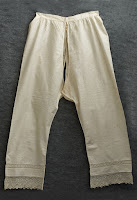 Drawers and similar undergarments were a direct imitation of men’s undergarments called “small clothes.” As such, they were considered masculine and therefore vulgar for ladies. In addition, drawers had two entirely separate legs with strings that tied around the waist and left open in the middle. For decades, the only women who wore them were prostitutes. Ladies of high society wanted nothing to do with this kind of garment.
Drawers and similar undergarments were a direct imitation of men’s undergarments called “small clothes.” As such, they were considered masculine and therefore vulgar for ladies. In addition, drawers had two entirely separate legs with strings that tied around the waist and left open in the middle. For decades, the only women who wore them were prostitutes. Ladies of high society wanted nothing to do with this kind of garment.
In 1817, some fashionable ladies wore pantaloons, a longer, lace-edged variation of drawers that were meant to be seen below the petticoat. In English Women’s Clothing in the 19th Century, by C Willet Cunnington, the author describes drawers as “frilled trousers” but goes on to state that the fashion disappeared almost immediately, adding, “On the whole however, it seems probable that most women did not wear any garment of this kind until the ’30’s” (meaning the 1830’s).
Before you continue, I must warn you: the colored drawings below are a tad graphic, so please don’t send me hate mail.
Risqué Regency Era Cartoons
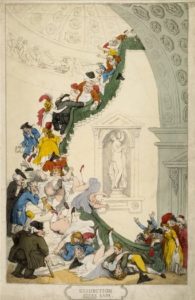 The lack of any garment underneath ladies’ skirts was such common knowledge that even social and political cartoons of the day reflected this. Thomas Rowlandson, a famous illustrator and cartoonist, created watercolors of soldiers, wars, death and dying, the hunt, several humorous series, as well as some rather erotic pieces. I have not included those in this post. You’re welcome.
The lack of any garment underneath ladies’ skirts was such common knowledge that even social and political cartoons of the day reflected this. Thomas Rowlandson, a famous illustrator and cartoonist, created watercolors of soldiers, wars, death and dying, the hunt, several humorous series, as well as some rather erotic pieces. I have not included those in this post. You’re welcome.
One of Rowlandson’s pieces is called Exhibition Stare Case (pictured to the left). In this image, several people are tumbling down the stairs. Three of them are misfortunate ladies, positioned with their legs up, revealing naked thighs and bums. This suggests ladies did not wear drawers or pantaloons.
Other satirical cartoons by different cartoonists including Cruikshank and Gilray show pictures of women falling off horses or, in the case of the picture to the right, warming themselves in front of a fire. In all these drawings, women are wearing nothing underneath their skirts except stockings and shoes. (Don’t you love the fat cat lying in front of her as if it has just expired?)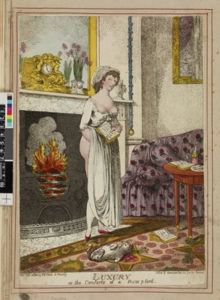
Obviously, back then, as today, political cartoons are only loosely based on fact. They’re supposed to be absurd. However, so many of them reveal (no pun intended) the lack of ladies’ undergarments that the combination begins to present a strong case against the practice, at least among the wealthier classes.
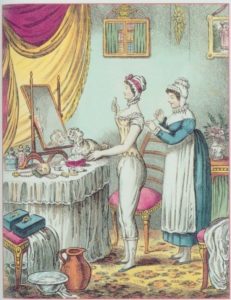 Another period drawing that addresses this is called “Progress of the Toilet.” It’s a set of three images published by James Gillray in 1810. His drawings are well-known to ridicule many practices of the Regency Era. Several of his creations mock the fashions of the period which dictated how the shapes of women should be altered to meet current standards of beauty.
Another period drawing that addresses this is called “Progress of the Toilet.” It’s a set of three images published by James Gillray in 1810. His drawings are well-known to ridicule many practices of the Regency Era. Several of his creations mock the fashions of the period which dictated how the shapes of women should be altered to meet current standards of beauty.
The image to the left does show a woman wearing drawers. It is difficult to see, but she’s wearing a chemise — you can see the sleeves and the edge around the top of her stays — which seems to be tucked into her drawers. The stays appear to be from earlier in the century when ladies wore Georgian stays, as evidenced by the little tabs on the bottom of the stays. But I digress. It’s also possible the cartoonist showed drawers to further ridicule the complicated process of dressing for the day and even perhaps to poke fun at the drawers themselves. Unfortunately, I was unable to determine the exact date of the image. One source said this series was created in 1810 but I have not been able to verify that. I find it more likely that it was around 1817 during that blip when drawers were popular.
Pantaloons
In 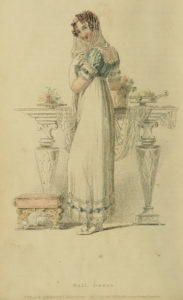 the 1820s, which was the Victorian Era, long pantaloons (also called pantaletes) arrived on the scene with more popularity. The term can be confusing because men wore pantaloons — silk breeches that went to the knee — for formal occasions until well into the 1820s until trousers became mainstream fashion.
the 1820s, which was the Victorian Era, long pantaloons (also called pantaletes) arrived on the scene with more popularity. The term can be confusing because men wore pantaloons — silk breeches that went to the knee — for formal occasions until well into the 1820s until trousers became mainstream fashion.
None of my books of Regency fashion prints show drawers or anything of the kind peeping out from underneath skirts — not even those labeled “walking dress,” “carriage dress,” or “riding habit.”
My Conclusion
While some historians stubbornly claim that women wore drawers, there is too much proof to the contrary. I suspect that just as today some men and women don’t always wear underwear, there were those ladies during the Regency while most did not. Our modern-day sensibilities might make the idea of not wearing underwear sound a tad obscene. Just remember, they had far different viewpoints about a great many things during the Regency.
Sources:
English Women’s Clothing in the Nineteenth Century by C. Willet Cunningham
Fashions in the Era of Jane Austen by Jody Gayles
http://www.janeausten.co.uk/corsets-and-drawers-a-look-at-regency-underwear/
https://janeaustensworld.wordpress.com/2010/11/06/ladies-underdrawers-in-regency-times/
http://www.fashion-era.com/drawers-pants-combinations-knickers-fashion.htm
https://englishhistoryauthors.blogspot.com/2011/11/regemcy-era-ladys-prodigious-layers-of.html

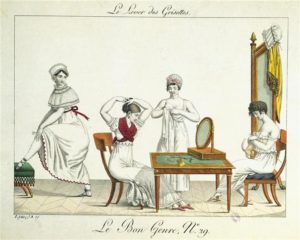
This is so fascinating, Donna! I just keep thinking about Elizabeth Bennet who is quite fond of walking and how much chafing they’d have with skin rubbing against skin all the time. And it would feel so much colder. It really doesn’t make sense from our modern viewpoint. What a different world they lived in.
Assume, for everyday wear,fall and winter, that Jane Austen wore wool blend dresses, with a flannel petticoat,and possibly when walking out of doors-had one or more flannel petticoats on, plus a long coat, a linen cap and over that cap-poss. a sturdy bonnet with scarf and gloves…
;(poss. wool socks and half boots).
There’s an entry in the Glenvervie Journals about Lady de Clifford’s criticism of Princess Charlotte’s exposed underdrawers in October, 1811. The entry states “She was sitting with her legs stretched out, after dinner, and showed her drawers, which, it seems, she and most young women now wear.” Lady de Clifford seems to be criticizing the princess not so much for wearing drawer as that they are too long and show. https://archive.org/stream/glenberviejourna00glenuoft#page/152/mode/2up/search/princess+charlotte
One source of confusion is that both what we call pantalettes and drawers were often called drawers. I think Princess Charlotte wore the drawers– or pantalettes that were meant to be seen. The woman who wrote to a friend that she lost one leg of her drawers probably meant her pantalettes because drawers had a seat. I take the cartoon of the woman getting dressed with her wearing drawers as a depiction of what people actually wore. The cartoonist who showed the naked bottoms did so because they were drawing a certain class of women and they meant to shock. I think many women of all classes wore drawers if only during certain days of the month. It isn’t something most would write about. However, I also realize that going to the privy or Watercloset in long skirts was difficult enough without having to pull down or fuss with drawers. So I am on the side of those who say some women wore drawers and one can’t tell how ordinary people lived from the cartoonists.
When you consider the amount of clothing a lady had to wear and the lack of convenience in toilette facilities, it makes a great deal of sense they did not wear drawers. It is difficult in this day and time with all the conveniences to imagine traveling by coach and needing to stop and relieve oneself. If you’ve ever experienced being in the hospital and having to use a bed pan can be disastrous for a female with only a hospital gown. Using a chamber pot in all that clothing? Goodness, holding the dress, chemise, etc. up would be a challenge, much less drying to deal with even the split drawers. Cleanliness was a difficult task in itself in those days. **One of Prince Regents complaints about the woman he was forced to marry. Eww** Also, the Regency era was time when women were attempting to reduce the weight of their attire. It is also difficult to imagine when drawers were introduced to females, they were considered immodest purely due to the fact they were a male garment, very vulgar indeed! Only a woman of easy virtue would consider wearing them! LOL! In researching around the Regency Era, it is no wonder ladies had maids to dress them. Men think they have to wait on a woman to dress today.
This is so surprising. What did women do when it was their time of month?
Thank you for another fascinating article. This is surprising! I don’t want to be indelicate, but my practical nature is curious how ladies managed their “time of the month” without wearing drawers? Thank you!
Hi Tania. Thanks for stopping by. Sorry for the slow response.
Good question! For that, women wore a fabric belt around their waists and then tied or pinned several layers of fabric, folded to make a pad, to that belt. My mother said that in her day, before adhesive sanitary pads, they used pads that had tails on each end and pinned the tails to a soft elastic belt worn around the waist. Also, the drawers that came a little later were open “down there” so there was no place to affix a pad or sanitary napkin to the drawers. Panties with crotches were a much, much later invention.